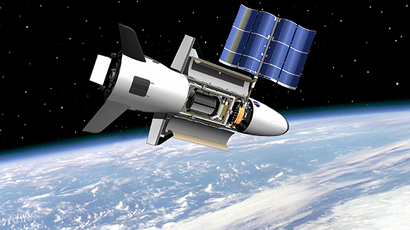Air Force researchers test Google Glass for combat, intelligence missions

A US Air Force research team is in the process of beta-testing Google Glass headsets for possible utilization in battlefield scenarios.
The BATMAN evaluation group at the US Air Force’s 711th Human Performance Wing is a highly-distinguished military research and development faction. According to VentureBeat, that unit is interested in Google Glass for its ability to “access information very quickly,” says Andres Calvo, a software developer and civilian contractor with the team.
The BATMAN (Battlefield Air Targeting Man-Aided [K]nowledge) team wants to test Google Glass for possible use by forward air controllers to help fighter and bomber aircraft locate targets, for search and rescue teams, and to aid combat controllers’ communication with aircraft and ground troops, among other uses.
The testing comes as the US military attempts to move from using laptops in combat and intelligence missions to more convenient, flexible smart phones, tablets, and wearable technology like Google Glass.
For the Air Force, positives of Google Glass include “its low power, its low footprint, it sits totally above the eyes, and doesn’t block images or hinder vision,” says 2nd Lt. Anthony Eastin, a behavioral scientist on the BATMAN team. The group comprises of both military and civilian behavioral and technology experts.
The group said the Air Force obtained two pairs of glasses like civilians have, through Google’s Glass Explorer program that requires applicants to pay US$1,500 if approved.
Eastin said the BATMAN team has no affiliation or relationship with Google at this time.
Google representatives confirmed to VentureBeat they do not have a stake in the project or a relationship with its researchers “nor does it have any plans to,” a source says. Though the tech behemoth would score a lucrative payday should the Air Force decide to escalate its use of Glass.
The Air Force research team said it is also developing proprietary software to enhance the Android OS that Glass uses.
“The goal is to build software for research purposes for future endeavors,” Eastin says.
VentureBeat reported in February that the US Navy is working on “smart goggles” with another company, Vuzix.
The New York City Police Department – a top-ten global security force – is currently experimenting with Google Glass for potential use in terror investigations and routine street policing purposes, according to VentureBeat.
BATMAN’s head engineer, Dr. Gregory Burnett, said the team was formed in 2001 to enhance a multitude of Air Force capabilities. Glass is ideal for the Air Force according to Burnett, but “the question is, during the chaos of war, how will the technology perform?”
According to the 711th Human Performance Wing’s website, the three elite-research units it comprises of are tasked with advancing “human performance in air, space, and cyberspace through research, education, and consultation.”














